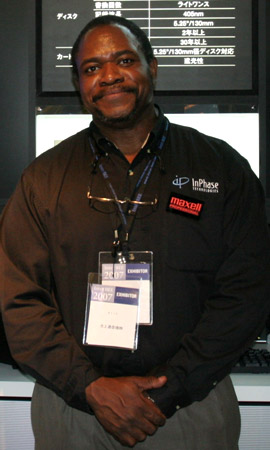William L. Wilson, Ph.D.

Chief Scientist, Founder, InPhase Technologies, USA
Since the earliest days of human history man has used an array of visible optical strategies for storing, sharing and archiving information. From the cave drawings of pre-historic times to the Blue-ray disks of today, optical technologies have dominated the way we’ve saved and transferred information throughout history. Holographic storage of digital information is the next step in the optical technology journey. Using holographic approaches one can envision, for example, storing 10’s of Gigabytes of information on media the size of a postage stamp.
The way we watch movies, television, listen to music, and store all kinds of data is changing. Soon it'll be possible to get everything you need or want saved on a disc no bigger than your thumb. "So instead of having your movie on something the size of a standard disk, now you can talk about putting a movie on something maybe the size of a postage stamp -- if not smaller," Bill Wilson, chief scientist at InPhase Technologies in Longmont, Calif., tells DBIS.
Just think ... Your favorite movie or collection of songs stored on a single disc. Physical chemists say holograms are the holy grail of data storage. Wilson says, "In many ways you can think of our disk as -- it's basically a library." Two intersecting lasers store millions of bits of information on a disc. It's that intersection of those two beams that actually allows you to record the holographic data and later recover it. It's the same concept as the images on credit cards we're all familiar with. Unlike the way information is stored on a CD, holographic storage stores information below the surface. And holographic storage promises to solve the movie industry's current "memory nightmare," thanks to optics. Right now all movies are stored on film because of its long shelf life. Even an epic like "Gone With the Wind," would take up only a tiny bit of holographic space. "You know, Blockbuster could send out a disc with the top 50 movies of the month," Wilson says. The technology is here, now it's a question of how it will be used. "Well, that's a question for Warner Brothers."
InPhase Technologies and the Maxell company, known for VHS tapes, will start offering holographic storage systems for professionals late next year. The movie and broadcast industries will likely follow, but consumer products may take a while before they reach the marketplace.
William L. Wilson is Founder and CSO of InPhase Technologies in Longmont, Colorado. Dr. Wilson has had more than 25 years of research and development experience in photonics and optoelectronics. Prior to joining InPhase Dr. Wilson was a Distinguished Member of Technical Staff at Bell Laboratories, Lucent Technologies in Murray Hill, NJ.
Dr. Wilson holds a Bachelors of Science degree in Chemistry from St. Joseph’s University and a Ph.D. in Physical Chemistry from Stanford University. Dr. Wilson has authored more than 100 publications and holds more than 20 US Patents.
Article written for the American Institute of Physics series Discoveries and Breakthroughs in Science by Ivanhoe Broadcast News.









